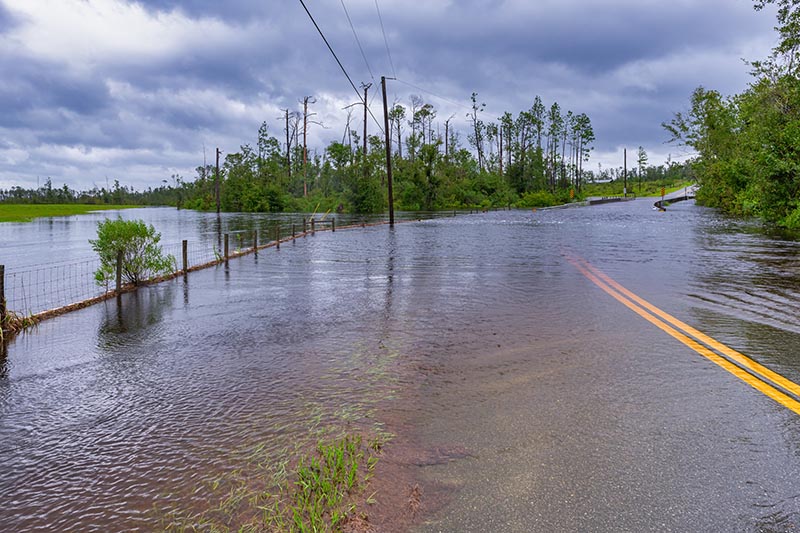Hurricane Sally Recovery Could Cost Up To $10B

UNITED STATES—September 21, 2020—As Hurricane Sally cleanup began on Friday, hundreds of thousands of people were still without power in Alabama and Florida. The storm, which dropped more than two feet of rain in some areas, damaged a bridge in Pensacola, Fla., tossed boats onshore, tore roofs off buildings, and flooded roads and homes, leaving many residents already impacted by the recession struggling to pick up the pieces, according to the Associated Press. Two people were killed in Alabama and a kayaker in Florida is missing.
Recovery from Hurricane Sally is expected to take many months. In Florida, officials in Escambia County, home of Pensacola, estimate at least $21 million in storm damage to roads, drainage systems, and other public infrastructure, according to the AP. The brand new Three Mile Bridge connecting Pensacola to the beaches was severely damaged, and officials have yet to estimate the cost or timeline of repairs. Restoring the sand washed away from Pensacola beach will take another $8 million. The Insurance Journal reports that Sally likely caused about $5 billion in immediate damage, with eventual recovery costs likely to total $8 billion to $10 billion.
The Atlantic hurricane season continues to churn out storms a record pace, with one area of the country struggling to recover as another area scrambles to prepare for the next blow. The AP reports more than 40,000 people around Lake Charles, La. are still waiting for power to be restored after Hurricane Laura devastated the area nearly a month ago. On the heels of Hurricane Sally, Tropical Storm Beta is taking aim at Texas, expected to make landfall late Monday or early Tuesday before moving up the Texas coast and into Louisiana, likely impacting some of the same areas that were hard-hit by Hurricane Laura. Beta is the 23rd named storm this year with more than two months remaining in hurricane season.
September 16, 2020
Hurricane Sally Threatens Catastrophic Flooding to Alabama, Florida
UNITED STATES—September 16, 2020— Hurricane Sally made landfall early Wednesday as a Category 2 storm near Gulf Shores, Ala. with 105 mph winds that downed trees and caused power outages for more than half a million customers in Alabama and Florida, according to CNN. As Sally crawls inland at just 3 mph, catastrophic flooding from heavy rain coupled with storm surge remains the biggest threat to southern Alabama and the Florida Panhandle.
Some areas have already received more than 15 inches of rain and isolated totals of up to 35 inches are possible by the storm’s end. CNN reports streets in Pensacola, Fla. are completely flooded, shops in Orange Beach, Ala. are sitting in a foot of water, and the National Weather Service in Mobile, Ala. issued a flash flood emergency warning, urging residents to seek higher ground due to life-threatening flood conditions. The flooding has already led to numerous water rescues in Alabama and Florida as residents began calling for help to escape the rising waters. In some cases, emergency workers were forced to delay their response to the calls until storm conditions improved, according to CNN.
As Hurricane Sally continues its sluggish track, the storm could dump 4 to 12 inches of rain across central Alabama and central Georgia, causing more flash flooding. By week’s end, parts of the Carolinas could see 4 to 9 inches of rain, according to CNN. In recent years, some of the most devastating storms in the U.S. have been the lingering, slow-moving cyclones that bring days of torrential rain and flooding, such as Tropical Storm Imelda just last year, Hurricane Florence in 2018, and Hurricane Harvey in 2017 which is one of the top two costliest U.S. storms on record.
Continuing the Atlantic hurricane season’s record-breaking pace, Sally is the fourth hurricane and eighth named storm to make landfall in the U.S. this year. The U.S. has not endured four hurricanes by September 16 since 2004 and has never been struck by eight named storms by this date.
September 15, 2020
Hurricane Sally Threatens Gulf Coast With Massive Rainfall
UNITED STATES—September 15, 2020— Hurricane Sally, currently a Category 1 storm, is inching toward the Mississippi coast at just 2 mph as its outer bands batter Alabama and the Florida Panhandle with rain. Forecasters are telling residents to prepare for a potentially historic rainfall event that could bring 10 to 30 inches of rain and significant flooding to southern Mississippi, southern Alabama, and the Florida Panhandle with flash flooding possible well inland, according to CNN. The slow-moving storm will likely not make landfall until early Wednesday near the Mississippi-Alabama state line, and life-threatening storm surge of 6 to 9 feet is expected along the Mississippi and Alabama coasts.
With maximum sustained winds at 85 mph, downed trees and power outages are likely and tornados are also possible. Hurricane Sally’s forecasted track has shifted several times, leading to uncertainty about its precise landfall, according to The New York Times. Louisiana, Mississippi, and Alabama have all announced mandatory evacuations of coastal areas ahead of the storm. Shelters have been opened for evacuees, but they are operating at reduced capacity due to COVID-19.
At the peak of what has been a record-breaking hurricane season, there were five tropical cyclones churning in the Atlantic on Monday for just the second time on record, according to The Washington Post. As Hurricane Sally crawled toward the Gulf Coast, Hurricane Paulette made landfall early Monday in Bermuda as a Category 1 storm. Tropical Storm Teddy formed early Monday between the Cabo Verde Islands and the Leeward Islands and is expected to remain at sea but strengthen to a Category 3 storm by Friday. Tropical Storm Vicky also formed out at sea and is expected to remain over open water until it degenerates by Thursday. Rene peaked as a tropical storm last week before weakening to a tropical depression in the Central Atlantic where it has continued to dissipate. Vicky marks the 20th named storm this season which has been churning at a record pace, far surpassing the seasonal average of 12 named storms.












